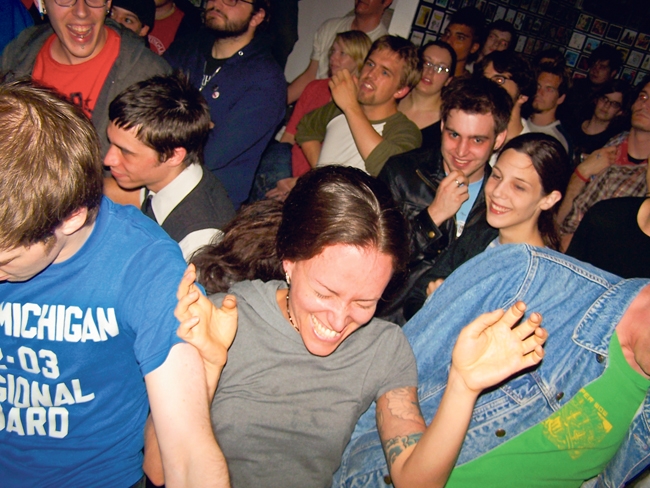In July, we found out all-ages, D.I.T. (Do It Together) venue the Division Avenue Arts Collective would close its doors at 115 S. Division Ave. on Aug. 1. The news came from a letter posted on the DAAC's homepage titled "Sad News." In it, readers found out the space where the DAAC resided for nearly 10 years had been sold. Recently, a town hall meeting was held in order to determine the next step for the venue.
A Vibrant Cultural Core Includes Emerging Artists
There's been a lot of ink spilled lately about the closing of the longtime home of the Division Avenue Arts Collective, and this is sad news indeed. Just short of its tenth year, this key anchor on the Avenue for the Arts played a vital role as an open platform for experimentation and cross-fertilization, especially for young and emerging artists. Although I'm a relative newcomer to Grand Rapids, the editor of REVUE thought I might have some insight. Recruited from Austin to be the director of the Grand Rapids Art Museum in July 2011, I've worked with contemporary art in New York, Houston, Boston and Tokyo. Considering GR, I researched the community's civic engagement, innovation and openness to creativity—essential for a forward-focused art museum.
From what I found online—and even more through experiences since I moved here—I know that the creative community of Grand Rapids is strong, deep, diverse and rich with potential. I have faith that wherever DAAC lands next, it will ignite fires of artistic and community innovation, but a downtown DAAC will help build a better cultural core. Let's step back from DAAC and give their leaders time to reimagine their future. When DAAC rises again, I hope it can play an active role in shaping a more sustainable creative ecosystem for our city, and be part of the upcoming civic dialogue focused on the future of downtown, including creative zones where the rules of the real estate marketplace work differently.
We need to plan for platforms like DAAC. Richard Florida, the sociologist who popularized the term "Creative Class," wrote that to thrive in the future, a city needs a convergence of a concentration of talented and creative people, a high velocity of ideas, and a high metabolism. With artists, entrepreneurs and medical researchers living and working within blocks of museums, high schools, art schools and universities, local restaurants and farmers markets, active urban parks and a beautiful river, the possibilities to catalyze a livable, sustainable and more creative city are multiplied exponentially.
As we in GR look forward, I am hopeful that our leaders will reach out to connect our arts ecosystem, our creative community, and local businesses to seek a path toward high-density, richly diverse, energizing urban environment that attracts, supports and retains artists and innovators of all types, generations, and cultural backgrounds. A vibrant cultural core requires opportunity for emerging artists.
Dana Friis-Hansen is Director and CEO of the Grand Rapids Art Museum, taking the helm in July of 2011. Prior to joining GRAM, he most recently served as Executive Director of the Austin Museum of Art. Friis-Hansen is an accomplished curator, writer, and editor with dozens of exhibitions, catalogues, books, articles, and published papers to his credit.
In their own words
We asked a handful of people involved in the local arts community for their memories and musings on the DAAC. Here's what they have to say:
"The issue with not having an experimental, cost effective venue for artists and bands to show and perform in is that they are forced 'underground' into basements and spaces that aren't always safe and certainly aren't open to the public. While those shows can be fun, it means there isn't a middle space for creatives to move from the basement into venues that are bars, restaurants or galleries. My concern is that challenging non-commercial works are going to get substantially less recognition." —Jenn Schaub, former DAAC board member
"An old boyfriend of mine took me on our first date there to see Kimya Dawson, and it was the most intimate, personal, unforgettable show I'd ever seen ... I loved that at the DAAC the performances felt like little gatherings – even when the place was packed wall-to-wall and stiflingly humid, with people standing almost on top of each other. I loved that you could get right up to the edge of the stage and stand inches from the artists who sing your favorite break-up/crying songs, and afterwards have a beer with them." —Sarah Jean Anderson, artist and comedienne
"Via the DAAC's Sunday Soup program, artists proved they would be there for each other as this mini-arts grant program awarded monies to creative projects in our community pitched to the audience/funders ... and always over a bowl of homemade soup. It was so rewarding to everyone even if you were not the winner that month." —Tommy Allen, artist and lifestyle editor for Rapid Growth Media
"I think it's looking pretty grim as far as the music scene goes. It was $80 to rent the room at the DAAC, then you make 10 percent of the ticket sales, whereas at The Intersection, you pay $400 for the room alone and only get back 20 percent of the tickets you have to sell." —Derek McAllister, vocalist/guitarist for Grand Rapids pop-punk band Small Town Victory
"The DAAC matters because it is a rare space that supports citizens in making and presenting new culture. It has produced shows, but also has produced meaningful organizational culture and many gifted cultural thinkers, workers, and leaders ... What is remarkable is the DAAC's consistent organizational inventiveness. Despite all of the great shows and projects, the persistence and imaginative tactics used to sustain the organization stand out as quite rare and unique." —Paul Wittenbraker, artist and Grand Valley State University professor
Pictured (top): Concert goers at the DAAC, circa 2005. Photo: Steven de Polo. Center: Jenn Schaub, photo by Ryan Pavlovich.





